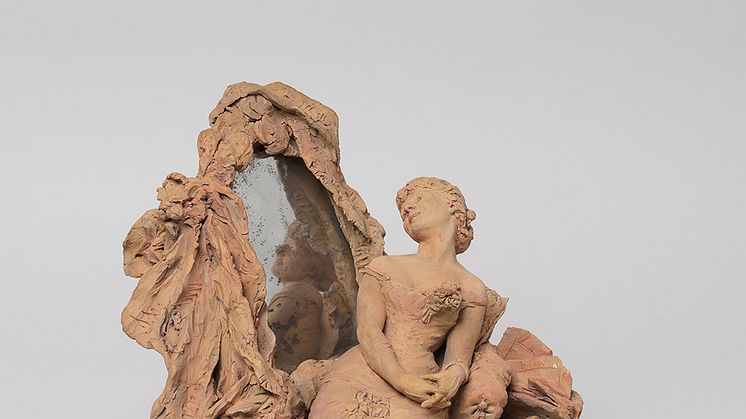
Press release -
Nationalmuseum’s latest sculpture acquisition: a detailed clay snapshot
Nationalmuseum has acquired a sculpture by Ingel Fallstedt (1848–99). The terracotta piece forms an entire spatial scene in miniature, showing a woman sitting in an armchair in front of a draped mirror. It was probably created in Paris, where Fallstedt lived from 1875 to 1881. This period coincides with the glory days of the actress Sarah Bernhardt (1844–1923), and the work can be seen in the context of the late 19th-century upsurge in theatre and popular culture.
Ingel Fallstedt is known for his skilful sculpting in clay, combining sketchlike whimsicality with precision. He studied at the Royal Swedish Academy of Fine Arts in Stockholm and in Munich, before joining many of his fellow artists in Paris. The painter Hugo Birger exhibited a similar motif to this sculpture, titled La Toilette, at the 1880 Salon. Birger and Fallstedt were friends and moved in the same circles in the French capital. They were likely acquainted with and inspired by the celebrated actress Sarah Bernhardt, who was at the height of her fame and personalized a new type of star. At that very time, around 1880, Bernhardt appeared in the play Froufrou wearing a spectacular dress similar to the one depicted by Birger and Fallstedt. She visited Sweden a few years later. Although we cannot say for certain that the sculpture was meant to portray Bernhardt, the composition resembles a scene in a stage play or a glimpse behind the scenes. While living in Paris, Fallstedt gained another connection to the theatre world when he married the Swedish actress Maria Lovisa Hammarstrand (aka Marie-Louise Hammarstrand, 1845–1929).
Linda Hinners, curator of sculpture at Nationalmuseum, said:
"This sculpture is an exquisite example of Ingel Fallstedt’s skill in working with clay to create a snapshot of a moment, capturing countless details such as the woman’s face, the dog, the dress fabric and the cushions in the armchair. The composition of the material, including mirrored glass and traces of paint, shows that Fallstedt had an experimental and innovative side, which is interesting from an art history perspective."
The work has been acquired for Nationalmuseum’s public collection thanks to a generous donation from the Hedda and N.D. Qvist Memorial Fund. Nationalmuseum receives no public funding for new acquisitions, but relies on gifting and financial support from private foundations and trusts to enhance its collections of fine art, applied art and design.
Facts
Ingel Fallstedt (1848–99)
Woman by a Mirror, c.1880
NMSk 2421
Sculpture signed at bottom right: “I.F”
Terracotta, traces of paint in places; mirrored glass. Wooden board (secondary)
H 34 cm, W 33 cm, D 36 cm
For more information
Linda Hinners, Curator of sculpture, linda.hinners@nationalmuseum.se, phone: +46 8 519 544 04
Lena Munther, Head of Communication, lena.munther@nationalmuseum.se, phone: +46 8 519544 65
Categories
Nationalmuseum is Sweden’s museum of art and design. The collections comprise some 700 000 objects, including paintings, sculpture, drawings and graphic art from the 16th century up to the beginning of the 20th century and the collection of applied art and design up to the present day. Nationalmuseum is a government authority with a mandate to preserve cultural heritage and promote art, interest in art and knowledge of art.

